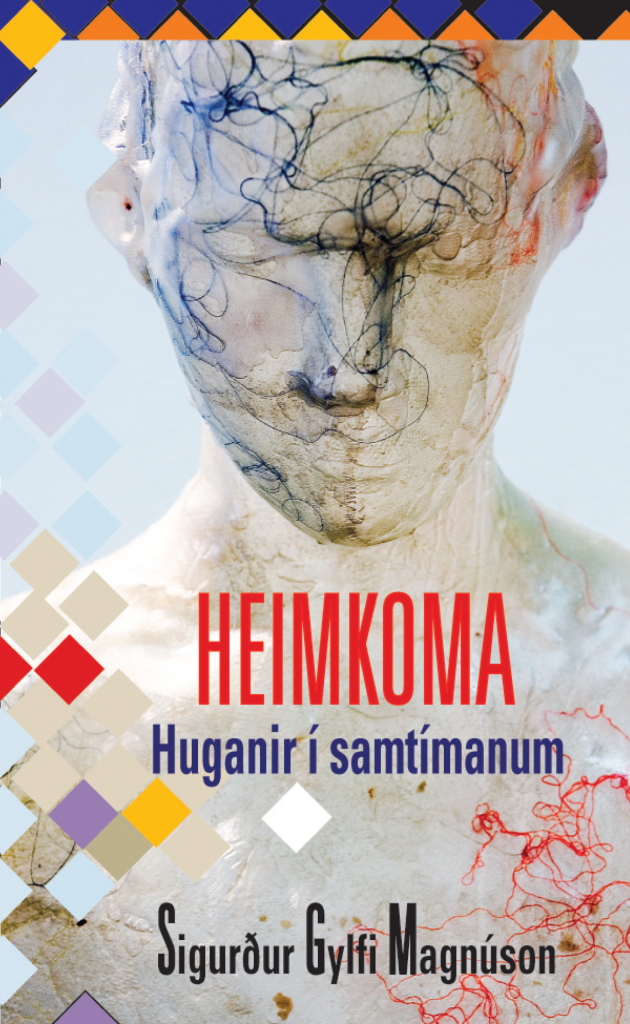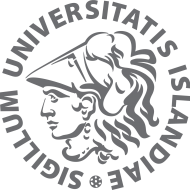Homecoming: Essays on Current Affairs. The Nameless book series (Reykjavík: The Center for Microhistorical Research at the Institute of History at the University of Iceland, 2016)
Nafnlausa ritröðin (Reykjavík: Miðstöð einsögurannsókna við Sagnfræðistofnun Háskóla Íslands, 2016) –
Foreword – Words and Communication in the West Wing
Academic debate consists, naturally enough, largely of words – interaction where ideas are put forward and formulated into text so that the ideas are clearly expressed. But that is not all that typifies debate: it takes place within a certain community, where the bonds between participants are of variable strength, and are grounded in different factors. This simple concept of interpersonal communication is, for instance, one of the pillars of university teaching: to stimulate a debate between teacher and students on the subject of the hour, which will be conducive to the development of both and their understanding of their discipline. This is a worthy undertaking, which is often, however, more complex than it may appear at first glance.
This book includes inter alia an example of such an attempt at dialogue, which took place in the spring of 2005 between myself and Hilma Gunnarsdóttir, a former student of mine. The debate took account, of course, of its time; it is, nonetheless, an excellent example of an exchange of views which, among other things, reveal the different viewpoints of teacher and student. Hilma and I worked closely together at the Reykjavík Academy, which was our workplace at the time. We were in the habit of discussing history and scholarship in general, together with some of her fellow-students, my students, within the Academy, in its west wing. The principal members of the group were Sigríður Backmann, Jón Þór Pétursson, Magnús Þór Snæbjörnsson and Guðný Hallgrímsdóttir, who all shared a large office for a time, close to my office. Others also got involved: Davíð Ólafsson, who was at that time pursuing doctoral studies at the University of St. Andrews in Scotland, regularly visited the Reykjavík Academy for some weeks at a time and played an active part in debates – also literary scholar Anna Einarsdóttir, wife of Magnús Þór, Bragi Þorgrímur Ólafsson, and several others who were members of the Academy at the time. It is safe to say that this period – extending over most of the first decade of the 21st century – had a major impact on all of us who took part in the debate. One of the products of the discussions was the dialogue between Hilma Gunnarsdóttir and me.
We were all keenly interested in how ideas traveled within the university community; where they came from, and how they were developed further in diverse academic disciplines. After having been at one of many seminars on offer, which Hilma and I attended at that time, we left at the interval after – in our view – rather a thin program, and determined to undertake an experiment with frank, public debate about university life, and to explore where such dialogue might take us. We began at the end of April 2005, and the dialogue drew to a close nearly two months later, when the tenth report was published on the Kistan.is / Kviksaga.is online journal, which was edited by Hilma and Jón Þór.
We received little response from our colleagues, though there were some who saw cause to challenge us – but they were far too few.
Signs of our group’s work appeared widely at that time: indications of our collaboration were promulgated in online journals, in lectures, or published in traditional books. A year later, in the spring of 2006, the group published, for instance, a 444-page volume, one month before the annual Icelandic History Convention. It was expressly intended as a critical contribution to the Convention. This had never been done before, and our sights were set high. The publication was: From Re-evaluation to Disintegration. Two Final Theses, One Introduction, Three Interviews, Seven Articles, Five Photographs, One Afterword and a Few Obituaries from the Field of Humanities. The Nameless series. Edited by Hilma Gunnarsdóttir, Jón Þór Pétursson and Sigurður Gylfi Magnússon. Published by the Center for Microhistorical Research and the Reykjavik Academy, 2006. 444 pages. – (Frá endurskoðun til upplausnar. Tvær prófritgerðir, einn formáli, þrjú viðtöl, sjö fræðigreinar, fimm ljósmyndir, einn eftirmáli og nokkrar minningargreinar af vettvangi hugvísinda. Ritstjórar Hilma Gunnarsdóttir, Jón Þór Pétursson og Sigurður Gylfi Magnússon (Reykjavík: Miðstöð einsögurannsókna og ReykjavíkurAkademían, 2006)). The group behind the publication held a seminar at the History Convention, which met with a harsh response from many renowned historians. The process by which our book was developed, and the response to it, were recounted elsewhere a year after its publication; part of that account is included at the end of this book as an afterword, casting an ever more detailed light on our collaboration and the phenomenon called there “dialogue history.” The foreword to From Re-evaluation to Disintegration is also included in the present volume.
At around that time Hilma, Jón Þór and Magnús Þór Snæbjörnsson were editing the online journal Kviksaga.is, and the two former also edited Kistan.is, as mentioned above. Some years earlier a large number of these people had been involved, with me, in the e-publication Rumors, Scandals and Trials: Eight Review Essays (Kviksögur, hneykslismál og réttarhöld: Átta ítardómar), published on Kistan.is in 2003, edited by Hilma and me. The formal dialogue concluded in 2007 when the group, under the leadership of Magnús Þór Snæbjörnsson, published a 156-page festschrift, Icelandic Culture II. Written in the Honor of Sigurdur Gylfi Magnusson 50 Year Old. Reykjavik, 2007. 156 pages. – (Íslenzk menning II. Til heiðurs Sigurði Gylfa Magnússyni á fimmtugsafmæli hans 29. ágúst 2007 (Reykjavík: Einsögustofnun, 2007)). The book included papers many of which related to my area of interest; but they were primarily an interesting contribution to the debate of the time – like most of what the group produced during that period.
After the publication of the festschrift the group split up, as some pursued further study at the University of Iceland, while others went on to universities abroad. Prior to that, however, I published a large volume in 2007: The History War. Essays and Narratives on Ideology, published by the Center for Microhistorical Research and the Reykjavik Academy, 2007. (Sögustríð. Greinar og frásagnir um hugmyndafræði (Reykjavík: Miðstöð einsögurannsókna og ReykjavíkurAkademían, 2007)) The book, which is 527 pages in large format, was in a sense my settling of accounts with history and several colleagues. Later the same summer another book followed: Academic Liturgy. Humanities and the Society of Scholars. Published by the Center for Microhistorical Research, 2007 (Akademísk helgisiðafræði. Hugvísindi og háskólasamfélag (Reykjavík: Miðstöð einsögurannsókna, 2007)), 337 pages. Both books had sprung from the atmosphere that had emerged within the group at the Reykjavík Academy in the early 2000s.
The vast majority of the papers in this book originated at the time of the group’s existence; they are brief comments or reviews about people, debatable historical issues, or books. I have divided the book into six parts under the headings: 1) impressions and ideas, 2) dialogue, 3) criticism, 4) review essays, 5) problems and social evils, and finally 6) viewpoints. Much of this material was published on Kistan.is, and some in Lesbók Morgunblaðsins – both of which have unfortunately closed down, as has Kviksaga.is – and also in the periodicals Saga and Sagnir and in the book From Re-evaluation to Disintegration. The eldest paper dates from 1997, but most were published in the first decade of the 21st century. Information is normally given on where and when they were originally published. There is no direct relationship between the individual papers, other than the dialogue between Hilma and me, naturally.
There are two reasons why I republish these texts now, after all this time: firstly, I have sometimes been asked where some of this material can be found – a person may have a vague memory of a paper I have written, such as „Við“ erum frábær! (“We” are wonderful!), which was published on Kistan in 2006; it censured the then President of Iceland, Ólafur Ragnar Grímsson, and his presentation of the history of Iceland and its supposed relation to the Icelandic so-called útrás or entrepreneurial expansion. This material has been hard to access, as Kistan has long since closed down. Now that paper and similar ones have been collected in this book, which will be published on the academia.edu website, where much of my writing from the start of my career to the present day is to be found (see http://hi.academia.edu/SigurðurGylfiMagnússon).
Secondly, I felt it was worth the effort to bring out how the group’s dialogues took place – how interaction between students and tutors shaped a series of events that undoubtedly had an impact on all who took part in it, and even influenced the development of the academic discipline in Iceland – and in addition to provide a little insight into this interest within the group: how ideas originate, and how they are worked through. I believe that we who were members of the group created a sort of academy within the academy, whose objective was to disrupt the conventional norms of scholarship and to seek to approach its subjects from another perspective than had been applied before. The group assuredly functioned in the spirit of the Reykjavík Academy at that time, when it saw itself as a setting for unconventional scholarly experiments. Much of the content of this book is thus to some degree uncompromising and polemical.
My return to Iceland after many years of doctoral study in the USA was a source of some anxiety – I was in a state of absolute uncertainty about my future. Yet I yearned to make my own contribution within the discipline, but in the end I felt there was little response, inter alia from scholars who belonged to the Icelandic history establishment. It may be said with some truth that my students came to my rescue, as they unhesitatingly strove to follow a path like the one I wanted to take, in the direction of new norms within scholarship and learning. It is another matter whether that process benefitted anyone. Each one of us must answer for ourselves! One thing is for sure: in time many people who belonged to the group left history to seek spiritual nourishment in other disciplines.
The book was published in electronic form only on: https://hi.academia.edu/SigurðurGylfiMagnússon

